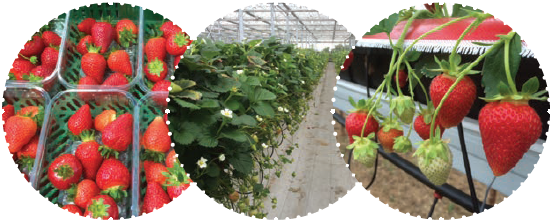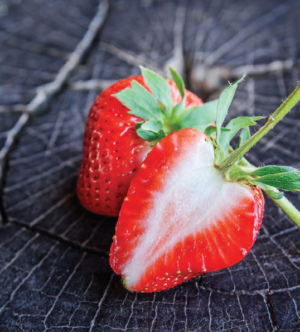Dr. Eamonn Kehoe, Teagasc soft fruit specialist provides an update on the introduction to the Irish market of the newest strawberry ‘Malling Centenary’
The ‘Malling Centenary’ strawberry was bred and released for the Centenary celebration of the East Malling Research (EMR) Centre, in Kent. The centre was founded in 1913 by an association of over 600 fruit growers and is most famous for its work on apple rootstocks. As well as soft fruit the research centre was also responsible for breeding a whole host of fruit cultivars including apples, pears, cherries, and hops.
Extending the strawberry fruiting season was a primary driver for the strawberry breeding programme. The strawberry cultivar ‘Pandora’ was released in 1988. This bridged the gap between the main and late season cultivars. Some of these included the raspberries (‘Malling Jewel’ and ‘Malling Juno’) and strawberries (‘Elegance’, ‘Judibell’, ‘Sunrise’, ‘Vibrant’ and ‘Sweetheart’).
On the day of the Centenary celebrations, a bowl of ‘Malling Centenary’ strawberries was presented to HRH the Princess Royal when she opened the celebrations. So these really are strawberries bred for royalty! The cultivar was also shortlisted for the plant of the year award at the 2013 Chelsea Flower Show.
JUNE BEARING STRAWBERRY
The cultivar ‘Malling Centenary’ is what’s known as a ‘June-bearing’ strawberry or, according to the scientific lingo, a ‘short day’ (SD) plant. This means these plants initiate flower buds on short days; the day length needed for such initiation is not fixed but is modulated by temperature. The lower the temperature, within limits, the fewer the days needed. These June-bearers fruit naturally in June and hence the name. The strawberry cultivar ‘Elsanta’, which is still the most popular cultivar grown here fits into this category. June-bearers are the most popular amongst commercial growers and are the result of decades of breeding for productivity, size, flavour, disease resistance and other attributes.
BENEFITS TO THE GROWER
‘Malling Centenary’ is classed as an early-midseason cultivar, making it suitable for early and extended season production. The main benefit is the very high percentage of Class 1 fruit with more than 90% being the norm. Whilst the yield so far is a little lower than ‘Elsanta’ the increase in operational efficiency, e.g. picking and packhouse speeds, easily makes up for any shortfall in respective yield. The fruit shape, size, and quality including shelf life are all excellent. Retailers in Ireland are very happy with the new strawberry. Customer feedback is very positive.
CROP HUSBANDRY
It’s important to remember also that this is a new strawberry cultivar. We have been growing ‘Elsanta’ predominantly in Ireland for almost 40 years. We are still learning new things about ‘Elsanta’ so we are not going to learn everything about ‘Malling Centenary’ overnight.
This also goes for the strawberry plant propagators, most of whom are based in the Netherlands.
They are equally on a steep learning curve with regard to perfecting plant propagation. Therefore, there are bound to be issues with plant quality, but they should be ironed out as we become more knowledgeable.
WILL THE CROP OVERWINTER?
So far the answer is generally positive. The plant’s leaf canopy is denser than ‘Elsanta’, which makes it more prone to grey mould (Botrytis). Any crops overwintered in glasshouses or closed plastic tunnels must be ventilated as much as possible to reduce the risk of this happening. From a crop production point of view, the yields and fruit quality from the second season of cropping are excellent.
The plant is also much less susceptible to powdery mildew (Podosphaera aphanis) infection.

This was demonstrated in our strawberry cultivar trial in Teagasc Kildalton College during the summer. This is a huge benefit for growers from both an agronomic and an economic perspective.
TEAGASC RESEARCH
The work in Teagasc Kildalton continues. Whilst the results of the research are important for the industry, what is even more important here is the ‘diffusion of knowledge’ to the current horticultural students. Most will never have seen applied research at work. Now they have their chance to see how horticultural research is undertaken and to participate in the process.
We have recently completed a new state of the art glasshouse unit (5.5m high) in the Teagasc Horticultural Centre at Ashtown in Dublin. I will start a new strawberry research trial here beginning in January, focusing on possible ways of extending the season of production of ‘Malling Centenary’. Even though ‘Centenary’ is a SD plant its flowering characteristics are quite different to that of a typical SD plant. In fact, some of the plant’s genetic makeup includes crosses from the east coast of the United States. These genes may be switched on in certain environmental conditions. I will manipulate the environment and try to extend the plants flowering and thus fruit production. This is an Aladdin’s cave for a horticultural scientist! ✽
 EAMONN KEHOE is a soft fruit specialist based at Johnstown Castle, Co Wexford, whose research is conducted at Ashtown Research Centre, Co Dublin. His primary focus is on providing a technical and business advisory service to Ireland’s soft fruit growers and conducting an applied research programme for the industry. He can be contacted at eamonn.kehoe@teagasc.ie EAMONN KEHOE is a soft fruit specialist based at Johnstown Castle, Co Wexford, whose research is conducted at Ashtown Research Centre, Co Dublin. His primary focus is on providing a technical and business advisory service to Ireland’s soft fruit growers and conducting an applied research programme for the industry. He can be contacted at eamonn.kehoe@teagasc.ie |






